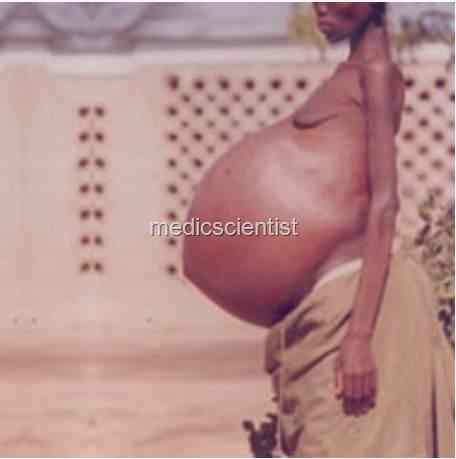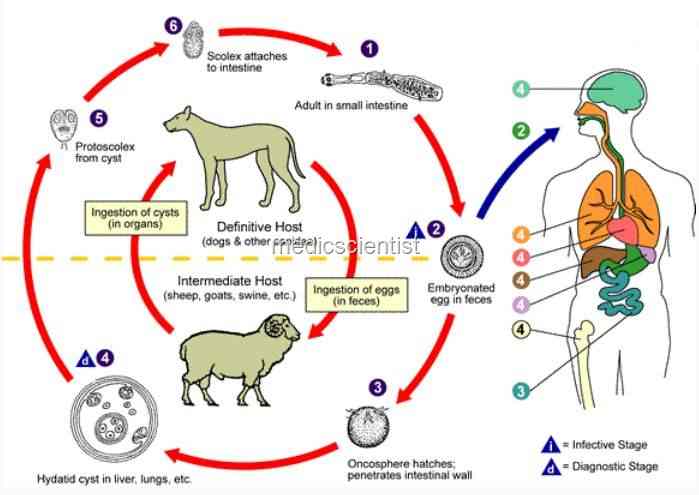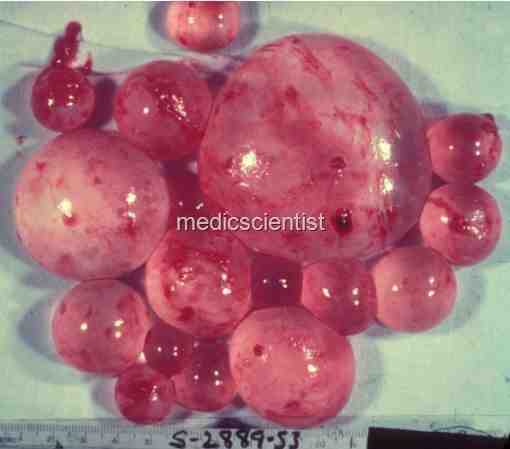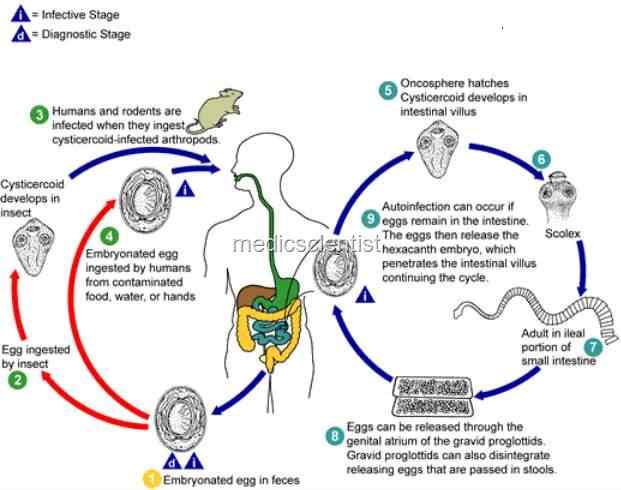Article Contents ::
- 1 ECHINOCOCCOSIS OR HYDATID DISEASE
- 2 Etiology OF ECHINOCOCCOSIS OR HYDATID DISEASE:
- 3 Clinical features OF ECHINOCOCCOSIS OR HYDATID DISEASE:
- 4 Diagnosis OF ECHINOCOCCOSIS OR HYDATID DISEASE:
- 5 Treatment OF ECHINOCOCCOSIS OR HYDATID DISEASE:
- 6 Contraindications —
- 7 Prevention ECHINOCOCCOSIS OR HYDATID DISEASE :
- 8 WHO recommendations state that medical therapy should be used for :
- 9 HYMENOLEPIASIS NANA
- 10 Treatment OF HYMENOLEPIASIS NANA:
ECHINOCOCCOSIS OR HYDATID DISEASE
Infection in humans is caused by larva of Echinococcus granulosus. The definitive hosts are dogs.
 |
| ECHINOCOCCOSIS OR HYDATID DISEASE Infection in humans |
- Eggs’are passed in the faeces of dogs.
- Cysts develop in man after ingestion of eggs.
 |
| HYDATID DISEASE Infection in humans is caused by larva of Echinococcus granulosus |
Etiology OF ECHINOCOCCOSIS OR HYDATID DISEASE:
- · After man eats the eggs, the embryos / larva penetrate the intestine, enter the portal circulation and go to the liver and lungs. The larvas develop into hydatid cysts.
- · Daughter cysts develop inside the hydatid cysts.
- New larvas also develop in brood capsules which are cystic structures inside the hydatid cysts.
- · The cysts increase in size and may even rupture.
 |
| Echinococcosis or Hydatid Disease LIFE CYCLE |
Clinical features OF ECHINOCOCCOSIS OR HYDATID DISEASE:
- · Echinococcal cysts enlarge and give rise to symptoms in the involved organ.
- · The liver and lungs are commonly involved.
- · Cysts may be accidentally detected on x-ray or ultrasound.
- · There is abdominal pain or palpable mass in the region of liver.
- · There may be compression of bile duct, biliary obstruction, jaundice.
- · Rupture or leak of cyst produces fever, itching, urticaria, eosinophilia and even anaphylaxis.
- · Pulmonary hydatid cysts may rupture into bronchial tree or peritoneal cavity.
- · There may be cough, chest pain, hemoptysis.
- · Cysts may also be present in bone, CNS, heart, pelvis.
- · The cysts may metastasize to spleen, lungs and brain.
 |
| Echinococcosis or Hydatid Disease CYSTS |
Diagnosis OF ECHINOCOCCOSIS OR HYDATID DISEASE:
- · Cysts may be seen in X-ray, ultrasound, MRI, CT scans.
- · Well-defined cysts with thick and thin walls like egg shell or thick lines may be seen on CT or uItrasou nd.
- · Aspirated fluid from cysts may show scolices and hooklets.
- · Serodiagnostic assay – Specific echinococcal antigens by immunoblot is a highly specific test.
Treatment OF ECHINOCOCCOSIS OR HYDATID DISEASE:
- potential treatment modalities, including, laparoscopic techniques, the PAIR (Percutaneous Aspiration, Introduction of a protoscolicidal agent and Reaspiration) procedure,
- and chemotherapy, which in certain cases, renders open techniques unnecessary
- Surgery should be done with care as the rupture of cysts can cause anaphylaxis.
- PAIR treatment (Percutaneous Aspiration, Infusion of drugs – scolicidal agents, Reaspiration) for cysts with multiple septa and cysts in the biliary tree.
- Albendazole 15 mg/kg/day in two divided doses 4 days before and 4 days after PAIR.
- Praziquantel – 50 mg/kg/day for 2 weeks. Albendazole for 3-6 months with or without PAIR.
Contraindications —
- Patients at the extremes of age
- Pregnant women
- According to the World Health Organization (WHO) recommendations, surgery is contraindicated in:
- Patients whose general condition is very poor
- Patients with multiple cysts or cysts that are difficult to access Patients with dead or totally calcified cysts
Prevention ECHINOCOCCOSIS OR HYDATID DISEASE :
- · Proper hygiene
- · Praziquantel to dogs to reduce infection.
WHO recommendations state that medical therapy should be used for :
- Multiple small liver cysts or cysts deep in liver parenchyma
- Peritoneal cysts Patients following incomplete surgery or relapse
- Patients with inoperable disease or those unfit for surgery
- Patients with multiple cysts in two or more organs
- Prevention of secondary spread of echinococcal infection following spontaneous rupture or aspiration of cysts
HYMENOLEPIASIS NANA
 |
| HYMENOLEPIASIS NANA |
 |
| HYMENOLEPIASIS NANA LIFE CYCLE |
- It is due to a tapeworm, common in children. It does not require an intermediate host. Usually asymptomatic.
- Anorexia, pain in abdomen and diarrhea occurs.
Treatment OF HYMENOLEPIASIS NANA:
- Praziquantel – 25 mg/kg single dose.

